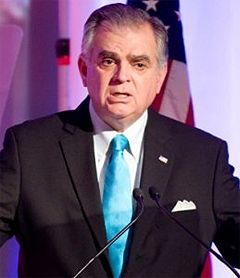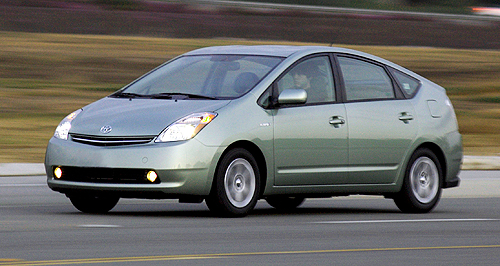Make / Model Search
News - ToyotaUS goes for Toyota jugular with $17.6 million fineEarly warning: Toyota documents reveal the Toyota floor-mat problem linked with unintended acceleration first surfaced in a Prius in 2006. Pain rolls on for recall-hit Toyota, accused of “knowingly hiding dangerous defect”12 Apr 2010 A MAXIMUM $16.4 million ($A17.6m) fine being sought by the US government against Toyota over tardy safety recalls for sticky accelerator pedals in its cars may not mark the end of the pain, as investigators are still trawling though 70,000 pages of documents supplied by the car-maker. If further breaches for “knowingly hiding a dangerous defect” are uncovered, each can draw a separate fine under US rules that require defects to be reported to the National Highway Traffic Safety Administration (NHTSA) within five days. According NHTSA documents quoted by Bloomberg in the US, accelerator pedals supplied to Toyota by CTS Corp “had two separate defects that may require two separate remedies”. This is interpreted to mean that a second fine might be recommended by US authorities. NHTSA said were it not for a statute limiting the civil fine announced last week to $16.4 million, Toyota could have faced a potential penalty of as much as $13.8 billion ($A14.7b), based on each of the 2.3 million vehicles involved in the recall qualifying for a fine of as much as $6000 each. According to the Toyota documents, the company received its first report that floor mats could entrap throttle pedals in February 2006 – more than three years before it issued a safety recall notice for the problem. Just five months after the mat problem surfaced in a Prius, Toyota also discovered that the accelerator pedals could stick. A timeline supplied to US authorities indicates Toyota did not act on the first sticky pedal report because the problem was not reproduced and no other similar reports were received. “Toyota decided to monitor the situation in the field,” the company said.  Left: US transportation secretary Ray LaHood. Left: US transportation secretary Ray LaHood.Proposing the maximum $16.4 million fine allowable under American law, US transportation secretary Ray LaHood said in a statement: “We now have proof that Toyota failed to live up to its legal obligations. “Worse yet, they knowingly hid a dangerous defect for months from US officials and did not take action to protect millions of drivers and their families. “For those reasons, we are seeking the maximum penalty possible under current laws.” A conviction by US authorities would also further expose Toyota to potentially expensive litigation, with numerous lawsuits for so-called “unintended acceleration” being filed. A panel of judges has ruled that those lawsuits related to unintended acceleration will be consolidated in a federal court in Santa Ana, California, near Toyota's US headquarters in Torrance - a suburb of Los Angeles. According to Bloomberg, Toyota is facing at least 177 consumer and shareholder lawsuits seeking class action status and at least 57 individual suits claiming personal injuries or deaths caused by sudden acceleration incidents. Many claimants say alleged defects in floor mats and pedals do not explain all the sudden acceleration incidents, instead pointing to electronic throttle controls. Toyota has repeatedly disputed assertions that electronics play a role. Documents supplied to US authorities by Toyota reveal a battle within Toyota about whether to tell the public of fundamental flaws in the working of the throttle – problems that had not at the time been fully understood by Toyota’s engineers and for which there was no clear “fix”. The company’s then American vice-president for public affairs Irv Miller, who has since retired, sent an e-mail in response to comments by a Japanese colleague, Katsuhiko Koganei, in Japan. Mr Koganei had argued that Toyota “should not mention about the mechanical failures of the pedal”, because the fault’s cause had not yet been identified and a statement by the company would unsettle motorists. “We are not protecting our customers by keeping this quiet,” Mr Miller replied. “I hate to break this to you but WE HAVE a tendency for MECHANICAL failure in accelerator pedals of a certain manufacturer on certain models.” While Toyota declined to comment on the Miller email, it reiterated that it had done “a poor job of communicating” recall issues. “We have subsequently taken a number of important steps to improve our communications with regulators and customers on safety-related matters to ensure that this does not happen again,” it said in a statement. “These include the appointment of a new chief quality officer for North America and a greater role for the region in making safety-related decisions. “As part of our heightened commitment to quality assurance, we are fully committed to being more transparent.” Toyota has recalled more than eight million cars globally after news of accelerator and brake problems surfaced last year. The incidents have been linked to at least 51 deaths. In Australia, 2378 third-generation Prius models have been recalled to apply a software fix to a brakes issue, described as “inconsistent feel”. In an unrelated setback in China, inspectors in Zhejiang province reportedly searched two Toyota spare-part storage facilities run by the company’s Chinese joint venture and found what they said were more than 1700 components that had not received the official certification for sale. Such violations can be subject to fines or temporary restrictions.  Read more |
Click to shareToyota articlesResearch Toyota Motor industry news |












Facebook Twitter Instagram